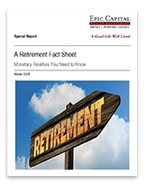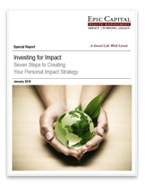The New Inherited Beneficiary IRA Rules
Feb 24, 2021
New inherited IRA rules took effect on January 1, 2020. The Setting Every Community Up for Retirement Enhancement (SECURE) Act became law on that day, altering the regulations on inherited Individual Retirement Account (I.R.A.) distributions.
The big change: the introduction of the 10-year rule for beneficiaries.
Most people who inherit a beneficiary IRA now have to empty that IRA of assets within ten years of the original owner’s death. You can do this as you wish; you can withdraw the whole IRA balance at once, or take incremental distributions on the way to meeting the 10-year deadline.1
Remember that tax rules constantly change. There is no guarantee that the tax treatment of Roth and Traditional IRAs will remain what it is now. This article is for informational purposes only. If you have inherited or expect to inherit a traditional or Roth I.R.A., be sure to consult a financial professional for real-world advice.
Are there exceptions to this rule?
Yes. If the deceased IRA owner was your spouse, you can treat the inherited IRA like an IRA of your own. If it is a traditional IRA, you generally must take required minimum distributions (R.M.D.s) from it once you reach age 72. The I.R.S. taxes those distributions as regular income, and if you take any distributions before age 59½, they may be subject to a 10% federal income tax penalty. If it is a Roth IRA, you aren’t required to take R.M.D.s. (You may continue to contribute to a Traditional IRA past age 72 as long as you meet the earned-income requirement.)1
Certain non-spousal beneficiary IRA accounts still have the chance to “stretch” inherited I.R.A. distributions over their remaining lifetimes, using Internal Revenue Service formulas (a choice available to most I.R.A. beneficiaries before 2020). You may choose this option if you are less than ten years younger than the original I.R.A. owner. You can also elect to do this if you meet the SECURE Act’s definition of a “disabled” or “chronically ill” individual (you have a life-altering physical or mental impairment or require extended care).1,2
Lastly, if a child inherits an IRA, they can take distributions based on the child’s life expectancy until the age of 18, at which point the aforementioned 10-year rule applies.1
If you are a Roth IRA beneficiary, be aware of the 5-year rule pertaining to Roth IRAs.
When you inherit a Roth IRA that is less than five years old at the time of the original owner’s death, any earnings taken from it will count as taxable income. If the Roth I.R.A. is more than five years old, you can take tax-free distributions from the earnings. Assets representing the original owner’s Roth I.R.A. contributions can become tax-free distributions regardless of when the original owner opened the Roth I.R.A.1
What’s the big takeaway from all this?
Suppose you are relatively young and anticipate a large IRA inheritance, and that big IRA is a traditional I.R.A. In that case, you can anticipate greater income taxes during the 10-year window when you take those inherited I.R.A. distributions.
By the way, the new rules do not apply to inherited IRAs whose initial owners died prior to 2020. If you are a beneficiary of such an IRA, then you may still attempt to “stretch” the inherited IRA assets according to I.R.S. life expectancy formulas and take IRAs as required by the old rules.3
For more insights and resources, be sure to sign up for our Weekly Market Commentary. Follow our YouTube channel where we regularly post our Epic Market Minute videos. Follow us on LinkedIn, or like us on Facebook. And as always, please don’t hesitate to reach out to a dedicated service professional at Epic Capital.
Tags: Current Events, Financial Planner Charlotte NC, Personal Finance, Retirement Planning, taxes
More Insights
Few terms in personal finance are as important, or used as frequently, as “risk.” Nevertheless, few terms are as imprecisely defined. Generally, when financial advisors or the media talk about investment risk, their focus is on the historical price volatility of the asset or investment under discussion.
As Americans get their grills and beach chairs ready for the July 4th holiday, the stock market and the weather across much of the country have both been on heaters. Stocks and bonds continue to effectively navigate a complex policy landscape shaped by evolving trade dynamics, geopolitical tensions, and fiscal stimulus. The market’s resilience in … Continue reading “Market Update – America Gets Record High Stock Prices for Its Birthday”
Birthdays may seem less important as you grow older. They may not offer the impact of watershed moments such as getting a driver’s license at 16 and voting at 18. But beginning at age 50, there are several key birthdays that can affect your tax situation, health-care eligibility, and retirement benefits.
During times like these when geopolitical headlines can be unsettling for investors, we at LPL Research like to remind ourselves of one of our key investing principles. Markets have always faced challenges —ranging from geopolitical conflicts and economic downturns to natural disasters, political upheaval and health crises. These events often trigger short-term volatility and shake … Continue reading “Why Long Term Investing Beats Selling in Volatile Times”
Are you concerned about the inheritance taxes your heirs may have to pay? Then you may want to consider creating charitable lead trusts.
Services
Epic Capital provides the following comprehensive financial planning and investment management services: Learn More >


 Top of Page
Top of Page











